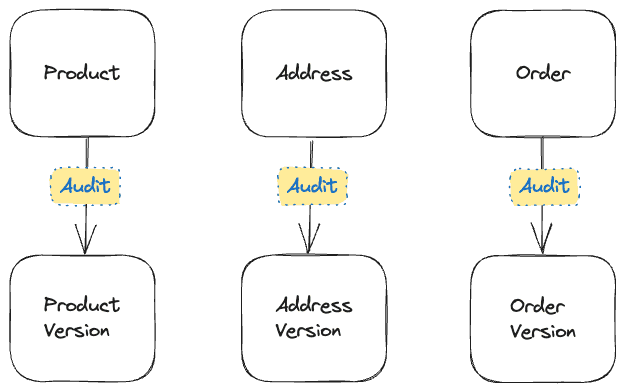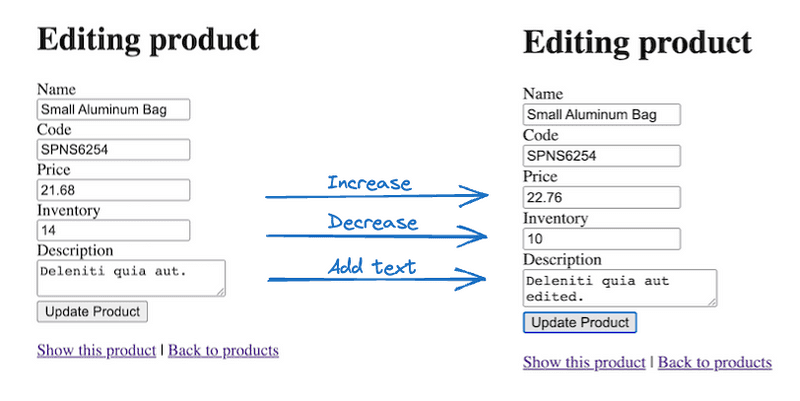Optimized Model Auditing with PaperTrail

Model auditing plays an important role in tracking changes within a Rails application. While several gems are available to implement this functionality, today we'll take a closer look at PaperTrail. By default, PaperTrail consolidates all model audit records into a single versions table, which could lead to performance and scaling challenges when dealing with numerous audited models. Conceptually, it looks like this:

Fortunately, there's a better approach. This post will walk through the steps to configure PaperTrail to create separate {model}_versions tables for each model, such as product_versions, order_versions, customer_versions, etc. This optimization can improve performance and organization in your application's auditing process. Conceptually, it will look like this:

Project Setup
We'll start with a simple project that has a single Products model to demonstrate how to audit changes to products specifically, but the process will apply to any number of models in a real application. Assume this is a back office application for maintaining an e-commerce system. This project uses a Postgres database, which supports the json column type and is useful for representing model changes. We'll also add the devise gem so we can have different users log in and make changes to products.
I'm using Ruby 3.2 and Rails 7.0.6 but you can check the PaperTrail Compatibility for older versions support. You can also check out the complete project on Github.
# Create a new Rails project using a Postgres database
rails new audit_demo -d postgresql
cd audit_demo
# Initialize an empty database
bin/rails db:create
# Generate product model, database migration, controller, views, and routes,
bin/rails g scaffold Product name:string code:string price:decimal inventory:integer description:text
# Create the `products` table
bin/rails db:migrateAdd devise to the Gemfile so we can have user logins, to later demonstrate how PaperTrail can keep track of who made a change. While you're here, also add the faker gem to the development and test sections, we'll use this later to generate sample data:
# Gemfile
# User authentication
gem "devise"
group :development, :test do
# Generate realistic looking data
gem "faker"
endRun bundle install to add these new gems to the project.
Run the Devise generators:
# Installs config/initializer for devise
bin/rails generate devise:install
# Generate user model, migration, modules, and routes
# for user registration and session management.
bin/rails generate devise User
# Migrate database so we now have a `users` table
bin/rails db:migrateUpdate the routes file to set the products listing view as the root route:
Rails.application.routes.draw do
# CRUD for products (generated from earlier scaffold command).
resources :products
# Added by devise generator to expose login and registration routes.
devise_for :users
# Set the default route: Devise needs to know where to redirect
# users after successful login.
root "products#index"
endTo ensure there's always a logged in user that's accessing the product views, specify the authenticate_user! method in the product controller's before_action callback (this is a helper method provided by devise):
# app/controllers/products_controller.rb
class ProductsController < ApplicationController
before_action :authenticate_user!
#...
endNow let's seed the database with a few users and products. I'm using the faker gem to quickly generate some realistic looking product data. To keep the db/seeds.rb file clean, I've split up the user and product seeds into separate files. For a small project like this, they could go all in the same file, but it quickly gets messy as the project grows, so I like to get in the habit of splitting up the seeds files right from the start:
# db/seeds.rb
if Rails.env.development?
load Rails.root.join("db/seeds/users.rb")
load Rails.root.join("db/seeds/products.rb")
Rails.logger.info("Seeding completed!")
else
Rails.logger.info("Seeding skipped. Not in development environment.")
end# db/seeds/users.rb
User.create!(email: "test1@example.com", password: "Password1")
User.create!(email: "test2@example.com", password: "Password1")# db/seeds/products.rb
20.times do
Product.create!(
name: Faker::Commerce.product_name,
code: "#{Faker::Alphanumeric.alpha(number: 4).upcase}#{Faker::Number.number(digits: 4)}",
price: Faker::Commerce.price(range: 0..100.0),
inventory: rand(0..50),
description: Faker::Lorem.sentence(word_count: 3, random_words_to_add: 4)
)
endFinally load the seeds into the database, I'm using the replant task which first truncates all the model tables. This makes it fast to re-run any time you want to reseed the database:
bin/rails db:seed:replantAt this point, you should be able to start a Rails server with bin/rails s, navigate to http://localhost:3000, get redirected to http://localhost:3000/users/sign_in, login as one of the example users from the seeds such as test1@example.com/Password1. You'll then be redirected to the product listing view which shows all products. You can click "Show product" on any product, then click "Edit" and make any changes.
Add PaperTrail
Now that we have a functioning project with authenticated users that can edit products, it's time to add model auditing. To start, add PaperTrail to the Gemfile, then run bundle install to install it:
# Gemfile
# Model auditing
gem "paper_trail"Next run the PaperTrail generator to generate the database migrations to add an audit table. I'm using the --with-changes column to ensure the model diffs will be persisted:
bundle exec rails generate paper_trail:install --with-changesThis generates two migration files as shown below - do NOT run these yet, we're going to be making a number of changes:
# db/migrate/20230806120211_create_versions.rb
class CreateVersions < ActiveRecord::Migration[7.0]
TEXT_BYTES = 1_073_741_823
def change
create_table :versions do |t|
t.string :item_type, null: false
t.bigint :item_id, null: false
t.string :event, null: false
t.string :whodunnit
t.text :object, limit: TEXT_BYTES
t.datetime :created_at
end
add_index :versions, %i[item_type item_id]
end
end# db/migrate/20230806120212_add_object_changes_to_versions.rb
class AddObjectChangesToVersions < ActiveRecord::Migration[7.0]
TEXT_BYTES = 1_073_741_823
def change
add_column :versions, :object_changes, :text, limit: TEXT_BYTES
end
endThe PaperTrail instructions then say to update any model classes that require auditing with the has_paper_trail macro. This will populate the versions table with a change record any time a model is updated (also persists model creation and deletion). For example, the Product model would get updated as follows. Again, do NOT make these changes, we'll be doing things differently:
class Product < ApplicationRecord
# Don't add this - we'll do it differently soon
has_paper_trail
end
class SomeOtherWidget < ApplicationRecord
has_paper_trail
end
# etc. for all model classes that need to be auditedThe above migrations and code change show that the default PaperTrail behavior is to generate a single versions table that will store all model audit records. Now let's go through the changes required to have a product_versions table specifically for persisting changes to the Product model.
Migration Changes
Make the following changes to the migration file:
- Change the file name from
db/migrate/{timestamp}_create_versions.rbtodb/migrate{timestamp}_create_product_versions.rb. - Modify the migration class name from
CreateVersionstoCreateProductVersions. - Modify the table and index names from
versionstoproduct_versions. - Add the
object_changescolumn from the..._add_object_changes_to_versions.rbmigration to..._create_product_versions.rband delete the second generated migration (there's no need to maintain a second migration file just to add the column). - Change the
objectandobject_changescolumns to be of typejson(orjsonbif using Postgres) rather thantext. - Remove the
TEXT_BYTESconstant as we're using json rather than text columns.
Here is the resulting migration file after making the above changes. I've added comments explaining what each column will store:
# db/migrate/20230806120211_create_product_versions.rb
class CreateProductVersions < ActiveRecord::Migration[7.0]
def change
create_table :product_versions do |t|
# Stores the model name, for model-specific version tables,
# will always be the same value per table, eg: "Product"
t.string :item_type, null: false
# The primary key of the model record being audited,
# for this case, will be a value from products.id
t.bigint :item_id, null: false
# The type of change happening to this model, eg:
# create, update, delete
t.string :event, null: false
# Optionally record who made the change
t.string :whodunnit
# JSON representation of the model BEFORE the change
t.json :object
# JSON representation of the changes made to the model attributes.
# Stores information about the attribute, its old value, and new value.
t.json :object_changes
# Timestamp when the audit record was created
t.datetime :created_at
end
# Create compound index for efficient querying
add_index :product_versions, %i[item_type item_id]
end
endModel Changes
By default, PaperTrail assumes all model changes are being persisted in a single versions table. We've updated the migration to create a product-specific versions table product_versions, but there are some code changes to be made as well to configure PaperTrail for custom version classes.
The first change is to specify the versions option on the has_paper_trail macro for the Product model, to indicate the class that represents the product versions (this class doesn't exist yet, we'll get to that next):
# app/models/product.rb
class Product < ApplicationRecord
has_paper_trail versions: {
class_name: "ProductVersion"
}
endNow add a new model class ProductVersion that inherits from PaperTrail::Version and specify the table name from the modified migration:
# app/models/product_version.rb
class ProductVersion < PaperTrail::Version
self.table_name = :product_versions
endFinally, since all the audited models will be persisted in custom versions tables and the default versions table will not exist in this app, we need to tell PaperTrail that the base ApplicationVersion class is abstract by specifying self.abstract_class = true. This is used in ActiveRecord models to indicate that a particular class should not be considered as a concrete table in the database:
# app/models/application_version.rb
class ApplicationVersion < ActiveRecord
include PaperTrail::VersionConcern
self.abstract_class = true
endWhodunnit
PaperTrail can optionally populate a whodunnit column in the {model}_versions table to record the logged in user that made the change. If the controller has a current_user method available, a controller callback can be specified that will automatically populate whodunnit with current_user.id. Since this project is using devise, there is a current_user helper method available on the controller, so we can specify the callback on the base controller as follows:
# app/controllers/application_controller.rb
class ApplicationController < ActionController::Base
before_action :set_paper_trail_whodunnit
endOne final small change to make is if you want the user's email address (or some other attribute) populated in the whodunnit column instead of the user's id, you can define the user_for_paper_trail method in the base controller. Then PaperTrail will use whatever is returned from this method to populate whodunnit:
# app/controllers/application_controller.rb
class ApplicationController < ActionController::Base
before_action :set_paper_trail_whodunnit
# Use devise gem's controller helper methods to return
# the logged in user's email address, or Anonymous if
# there is no logged in user.
#
# The value returned from this method will be saved in
# the {model}_versions.whodunnit column.
def user_for_paper_trail
user_signed_in? ? current_user.email : "Anonymous"
end
endDemo
Now we're ready to try this out and see the product-specific audit table populated:
- Start the Rails server with
bin/rails s - Navigate to http://localhost:3000/.
- When presented with the login prompt, enter
test1@example.com/Password1(fromdb/seeds/users.rb). - From the products listing page, click the
Showlink for any product. - From the product view page, click
Edit. - Make a few edits to the product and click the Update button.
For example, I've selected a product with code SPNS6254, and made some edits to increase the price (inflation!), decrease the inventory count, and make a small text change to the description:

Now launch a Rails console with bin/rails c to see what PaperTrail has saved for this update. Notice the versions for the product are returned as an array of ProductVersion model instances, which is the custom version class we created earlier:
# Find the product we just edited
product = Product.find_by(code: "SPNS6254")
# Our edits have been saved to the database
=>
#<Product:0x0000000111013df0
id: 103,
name: "Small Aluminum Bag",
code: "SPNS6254",
price: 0.2276e2,
inventory: 10,
description: "Deleniti quia aut edited.",
created_at: Mon, 07 Aug 2023 13:35:45.442271000 UTC +00:00,
updated_at: Sat, 12 Aug 2023 13:14:18.913169000 UTC +00:00>
# PaperTrail adds the `versions` method to audited models
product.versions
# It returns an array of records from `product_versions` table
# `whodunnit` shows email address of logged in user that made the change
# `object` column persists how the product looked BEFORE the change
# `object_changes` shows every value we updated
=>
[
#<ProductVersion:0x000000010d5f2180
id: 80,
item_type: "Product",
item_id: 103,
event: "update",
whodunnit: "test1@example.com",
object:
{
"name"=>"Small Aluminum Bag",
"code"=>"SPNS6254",
"price"=>"21.68",
"inventory"=>14,
"description"=>"Deleniti quia aut.",
"id"=>103,
"created_at"=>"2023-08-07T13:35:45.442Z",
"updated_at"=>"2023-08-07T13:35:45.442Z"
},
object_changes:
{
"price"=>["21.68", "22.76"],
"inventory"=>[14, 10],
"description"=>["Deleniti quia aut.", "Deleniti quia aut edited."],
"updated_at"=>["2023-08-07T13:35:45.442Z", "2023-08-12T13:14:18.913Z"]
},
created_at: Sat, 12 Aug 2023 13:14:18.913169000 UTC +00:00>
]We can also connect directly to the database to verify the data is persisted in the product_versions table. Use the bin/rails dbconsole command to launch a psql session. Then query the product_versions table for item_id of 103 (which is the primary key of the product record we edited earlier):
audit_demo=> select whodunnit, object_changes from product_versions where item_id = 103;
whodunnit |object_changes
-------------------+---------------------------------------------------------------------------------------------------------------------------------------------------------------------------------------
test1@example.com | {"price":["21.68","22.76"],"inventory":[14,10],"description":["Deleniti quia aut.","Deleniti quia aut edited."],"updated_at":["2023-08-07T13:35:45.442Z","2023-08-12T13:14:18.913Z"]}
(1 row)As shown from both the Rails and database consoles, PaperTrail has successfully recorded the update to this product record in the product_versions table.
Other Models
A real application will have multiple models that need to be audited. For example, an e-commerce application could have orders, addresses, payments, etc. To get model-specific audit tables populated for these, the steps are:
- Run the paper trail generator command:
bundle exec rails generate paper_trail:install --with-changes. - Repeat the steps in the Migration Changes section of this post.
- Repeat the steps in the Model Changes section of this post.
- Run
bin/rails db:migrateto create the new{model}_versionstable.
Conclusion
This post has provided a step-by-step guide to optimizing model auditing within a Rails application using the PaperTrail gem. By configuring separate, model-specific audit tables, you've gained insights into efficiently tracking changes while avoiding potential performance issues tied to a centralized audit structure. There's a lot more you can do with PaperTrail such as limiting what events get audited and reverting to previous versions. Checkout the docs for more details.



